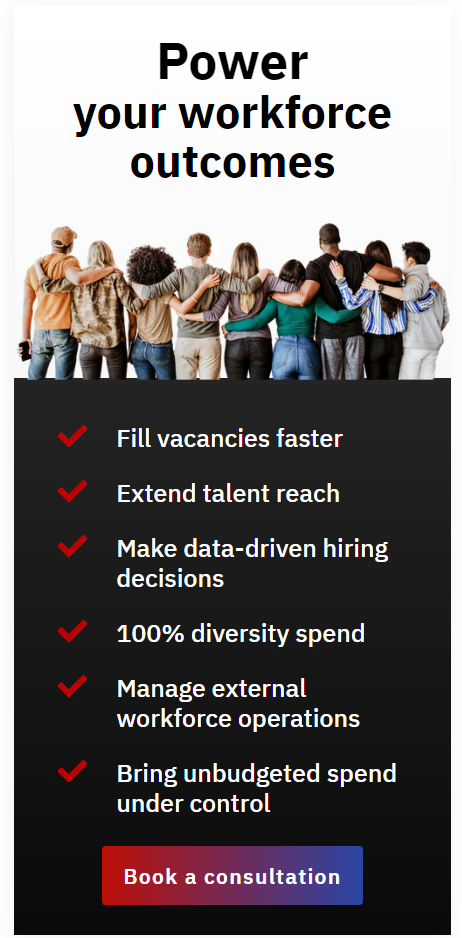Finding ‘people to do jobs‘ isn’t the same as finding ‘talent.’How do you fine-tune your talent acquisition approach to filter out the highest-level skills?
Finding ‘people to do jobs‘ isn’t the same as finding ‘talent.’ The term itself suggests that if you’re looking for talent, then there is a qualitative aspect to the qualities of the individual. It might be about professional or academic qualifications. Sometimes, it may be about culture fit. Other times it’s about on-the-job experience (so-called tacit knowledge). More often than not, it’s a blend of all these things plus a big blob of attitude, leadership acumen, and communication skills.
Top tips from the professionals
At Workspend, our consultants spend all of their time in front of customers helping them with their workforce planning, strategies, and talent sourcing approaches. Who better then, to ask for perspectives on what it takes to find the hardest-to-reach talent that every employer wants? This week, we held an internal workshop with our team of talent management and recruitment experts and these are the top tips they came up with:
1. The probability is, most of the best people are already in work.
It makes sense to target candidates from top employers. To widen your search look for candidates from the same or similar industries and seek out new starters from the better-ranked universities that offer good raw material to mold into your business ethos, operational approach, and tools etc.
2. Ask your candidates to take online tests.
While it’s only part of the story to uncover top talent, it’s impossible to completely ignore the importance of sound academic background, technical and professional skills. That’s why we’re big advocates of modern testing tools (like HackerRank.com) make it possible to validate the skills of individuals before going to the next step of qualifying the human-fit qualities you’re looking for.
3. Getting ‘behind the CV’ is really important.
Exposing the personality behind the grades has traditionally meant face-to-face interviews which are expensive and time consuming for hiring managers. Video interviewing gives recruiters another option. It helps to see beyond the technical skills. It means recruiters can learn about the passions, drivers, collaboration and communication skills of the individual through video interviewing while cutting the time and cost of a full interview process.
4. Most individuals fail in their role not because of their skills, but because of their temperament and ‘fit.’
For example, perhaps they’re not used to the level of exposure and scrutiny that comes from working for a small company; or dealing with matrix management in a large corporate. The expectations of hirers are vastly different. You’ll need detailed job descriptions with exact requirements, not just of the skills and competencies, but of the likely personality characteristics, working environment, and behavioral tendencies. Do you need a team player? Is the role expected to work largely alone under their own initiative? An ‘ideas’ person perhaps? You will need to dig out of the hiring manager the kind of human qualities are you’re looking for.
5. In the pursuit of top talent, you should see agencies as partners not adversaries.
To get the best out of them, you need to work collaboratively with suppliers. They should be informed of your expectations in full, to make sure that they know the qualities they’re looking for in candidates. Agencies too normally want to give candidates a great experience—but they need good information and cooperation to do it.
Final Thoughts
A hyper-competitive job market means employers can’t assume the best talent will come flocking to their door. Recruiters and talent professionals need to encourage their executive team to consider ‘the whole package’ and how best to sell it.
- Top talent generally speaking needs challenging roles, so that needs to be consistently shared with the candidates by the supplier, the MSP, and the client Hiring Manager
- You will need to sell both the benefits of the job role and of working for the company. It’s not enough to convince people to move from one employment to another simply by offering an above-average salary and benefits package.
- Your ‘brand’ does matter, and if your brand is not well-known, then you need to plow-in more effort into promotion. Remember, everything we know about millennials in the job market is they want to work for an organization with a purpose. They want to be involved in the organization they serve and have the ability to influence decisions. Equally important, they want to work for an organization with morals and ethics that match their own.
- Share details about exciting projects that they will be working on
- Offer avenues for a candidate to update their skillset and a possibility of being placed somewhere else if and when the project winds up
- For many, the biggest attraction will be the potential to become a fulltime employee, so if that’s a possibility, don’t forget to flag it.
About the Author
Sameer Srivastava has over twelve years experience in designing, implementing and managing MSP programs in Europe, Asia and the US. His current responsibilities include oversight of Workspend’s Strategic Center of Excellence based in New Delhi, India, and business operations in APAC and EMEA. Prior to joining Workspend, Sameer was leading Kelly OCG’s Implementation services in EMEA and later went to head their MSP and RPO Operations in India. Post Kelly OCG, Sameer was at Allegis Global Solutions where he managed Implementation and Operational teams in India. Sameer also has experience working as an IT and Change Management Consultant in the US and the UK. Sameer holds a bachelor’s in computer science from the University of Nebraska, Lincoln (USA) and an MBA from Cranfield University (UK). He can be contacted at [email protected] or follow him on LinkedIn.

